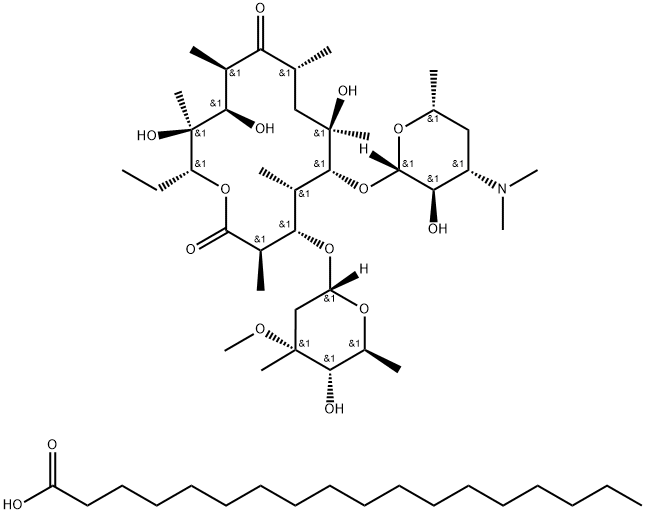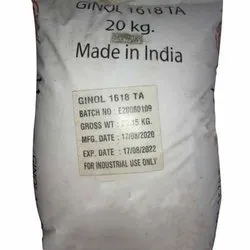1-Octadecanol
Synonym(s):1-Octadecanol;Octadecyl alcohol;Stearyl alcohol
- CAS NO.:112-92-5
- Empirical Formula: C18H38O
- Molecular Weight: 270.49
- MDL number: MFCD00002823
- EINECS: 204-017-6
- SAFETY DATA SHEET (SDS)
- Update Date: 2025-12-22 14:18:24

What is 1-Octadecanol?
Chemical properties
Stearyl alcohol, or 1-octadecanol, is an organic compound classified as a saturated fatty alcohol with the formula CH3(CH2)16CH2OH. It occurs as hard, white, waxy pieces, flakes, or granules, which have a slight characteristic odor and a bland taste. It is soluble in alcohol, acetone, and ether, but insoluble in water. Furthermore, it is combustible.
The Uses of 1-Octadecanol
1-Octadecanol is used to surfactant in cosmetics. It provides effective hydration to hands and face with pheohydrane which is a complex of the mico algae Chlorella Vulgaris and hydrolysed algin in a sea water base. It is a saturated alcohol of high purity and can substitute for cetyl alcohol in pharmaceutical dispensing, in cosmetic creams, for emulsions, textile oils and finishes, as antifoam agent, lubricant, viscosity agent, builder, and chemical raw material.
What are the applications of Application
1-Octadecanol is used as an emulsifier and thickener
Definition
ChEBI: Octadecan-1-ol is a long-chain primary fatty alcohol consisting of a hydroxy function at C-1 of an unbranched saturated chain of 18 carbon atoms. It has a role as a plant metabolite, a human metabolite and an algal metabolite. It is a long-chain primary fatty alcohol, a fatty alcohol 18:0 and a primary alcohol. It derives from a hydride of an octadecane.
Preparation
1-Octadecanol is prepared commercially via Ziegler aluminum alkyl hydrolysis or the catalytic, high-pressure hydrogenation of stearyl acid, followed by filtration and distillation. It may also be derived from natural fats and oils.
Production Methods
Historically, stearyl alcohol was prepared from sperm whale oil but is now largely prepared synthetically by reduction of ethyl stearate with lithium aluminum hydride.
What are the applications of Application
1-Octadecanol is a long chain primary alcohol that is used in the production of emulsions, textile oils, antifoam agents, and lubricants. Other large scale applications include the manufacture of alkyl amines, tertiary amines, ethoxylates, halides/mercaptans, and polymerization stabilizers. It generally occurs as a mixture of solid alcohols whose primary constituent is 1-octadecanol. It occurs naturally in sperm whale oil and has been isolated from the hyperthermophilic bacterium Pyrococcus furiosus.
1-Octadecanol has been used to model the plant epicuticular wax layer for an investigation by differential scanning calorimetry and Fourier transform infrared spectroscopy.
The use of 1-octadecanol to prepare microsphere formulations for such compounds as paclitaxel and indomethacin has been described.
Synthesis Reference(s)
The Journal of Organic Chemistry, 49, p. 2438, 1984 DOI: 10.1021/jo00187a028
Synthetic Communications, 12, p. 463, 1982 DOI: 10.1080/00397918208065953
General Description
Mixed monolayers of 1-octadecanol and ethylene glycol monooctadecyl ether were studied to investigate their evaporation suppressing performance. The rate dependence of the collapse pressure for an octadecanolmonolayer using axisymmetric drop shape analysis has been investigated.
Health Hazard
Mildly toxic by ingestion. Questionable carcinogen with experimental neoplastigenic data. A skin and eye irritant.
Fire Hazard
Flammable when exposed to heat or flame; can react with oxidizing materials. To fight fire, use foam, CO2, dry chemical. When heated to decomposition it emits acrid smoke and irritating fumes.
Flammability and Explosibility
Not classified
Pharmaceutical Applications
1-Octadecanol is used in cosmetics and topical pharmaceutical creams and ointments as a stiffening agent. By increasing the viscosity of an emulsion, stearyl alcohol increases its stability. 1-Octadecanol also has some emollient and weak emulsifying properties, and is used to increase the water-holding capacity of ointments, e.g. petrolatum. In addition, 1-Octadecanol has been used in controlled-release tablets, suppositories, and microspheres.It has also been investigated for use as a transdermal penetration enhancer.
Safety
Stearyl alcohol is generally considered to be an innocuous, nontoxic
material. However, adverse reactions to stearyl alcohol present in
topical preparations have been reported. These include contact
urticaria and hypersensitivity reactions, which are possibly due to
impurities contained in stearyl alcohol rather than stearyl alcohol
itself.
The probable lethal oral human dose is greater than 15 g/kg.
LD50 (rat, oral): 20 g/kg
Synthesis
1-Octadecanol is synthesized from Stearic acid, which may be obtained by saponification of Tallow, or hydrogenation of Cottonseed oil, from Castor oil or from other natural oils.
Storage
Stearyl alcohol is stable to acids and alkalis and does not usually become rancid. It should be stored in a well-closed container in a cool, dry place.
Purification Methods
Crystallise octadecanol from MeOH, or dry Et2O and *C6H6, then fractionally distil it in vacuo. Also purify it by column chromatography. Free it from cetyl alcohol by zone refining. [Beilstein 1 IV 1888.]
Incompatibilities
Incompatible with strong oxidizing agents and strong acids.
References
[1] P. SELVIN THOMAS. Electrical properties of natural rubber nanocomposites: effect of 1-octadecanol functionalization of carbon nanotubes[J]. Journal of Materials Science, 2011. DOI:10.1007/s10853-011-6174-4
[2] DIANA N. H. TRAN. Molecular Interactions behind the Synergistic Effect in Mixed Monolayers of 1-Octadecanol and Ethylene Glycol Monooctadecyl Ether[J]. The Journal of Physical Chemistry B, 2013. DOI:10.1021/jp401027c
[3] Rowe, R.C., Sheskey, P.J., & Quinn, M. (1994). Handbook of Pharmaceutical Excipients.
Properties of 1-Octadecanol
| Melting point: | 56-59 °C (lit.) |
| Boiling point: | 210 °C15 mm Hg |
| Density | 0.812 g/mL at 25 °C (lit.) |
| vapor density | 9.3 (vs air) |
| vapor pressure | <0.01 mm Hg ( 38 °C) |
| refractive index | 1.4356 (estimate) |
| Flash point: | 185°C |
| storage temp. | 2-8°C |
| solubility | methanol: soluble10mg/mL, clear, colorless |
| form | Flakes |
| pka | 15.20±0.10(Predicted) |
| color | White |
| Specific Gravity | 0.812 |
| Odor | wh. unctuous flakes or gran., faint odor, bland taste |
| explosive limit | ~8% |
| Water Solubility | insoluble |
| Merck | 14,8805 |
| BRN | 1362907 |
| Dielectric constant | 3.4(58℃) |
| CAS DataBase Reference | 112-92-5(CAS DataBase Reference) |
| NIST Chemistry Reference | 1-Octadecanol(112-92-5) |
| EPA Substance Registry System | 1-Octadecanol (112-92-5) |
Safety information for 1-Octadecanol
| Signal word | Warning |
| Pictogram(s) |
 Exclamation Mark Irritant GHS07 |
| GHS Hazard Statements |
H315:Skin corrosion/irritation H319:Serious eye damage/eye irritation H335:Specific target organ toxicity, single exposure;Respiratory tract irritation |
| Precautionary Statement Codes |
P261:Avoid breathing dust/fume/gas/mist/vapours/spray. P305+P351+P338:IF IN EYES: Rinse cautiously with water for several minutes. Remove contact lenses, if present and easy to do. Continuerinsing. |
Computed Descriptors for 1-Octadecanol
1-Octadecanol manufacturer
New Products
Indole Methyl Resin tert-butyl 9-methoxy-3-azaspiro[5.5]undecane-3-carboxylate Boc-His(Boc)-OH 2-CTC Resin 4-Chloro-7-tosy1-7Hpyrrolo[2,3-d]pyrimidine 5,7-Dibromo-1H-indole 2,5-dichloro-N-hydroxy-4,6-dimethylpyridine-3-carboximidamide 2,2-Dimethoxy-7-azaspiro[3.5]nonane hydrochloride 4-chloromethyl-5-methyl-1,3-dioxol-2-one (DMDO-Cl) R-2-BENZYLOXY PROPIONIC ACID 1,1’-CARBONYLDIIMIDAZOLE 1,1’-CARBONYLDI (1,2-4 TRIAZOLE) N-METHYL INDAZOLE-3-CARBOXYLIC ACID 4-((2-hydroxyethyl)thio)benzoic acid 1-(TERT-BUTOXYCARBONYL)-2-PYRROLIDINONE Methyl 6-methylnicotinate 3-Pyridineacrylic acid tert-Butyl carbazate TETRAHYDRO-2H-PYRAN-3-OL 2-((4-morpholinophenylamino) (methylthio) methylene) malononitrile 3-(4-morpholinophenylamino)-5-amino-1H-pyrazole-4-carbonitrile 2,4-dihydroxybenzaldehyde 1,3-Diethyl-1,3-Diphenylurea Methyl 2-methylquinoline-6-carboxylateRelated products of tetrahydrofuran








You may like
-
 1-Octadecanol CAS 112-92-5View Details
1-Octadecanol CAS 112-92-5View Details
112-92-5 -
 1-Octadecanol CAS 112-92-5View Details
1-Octadecanol CAS 112-92-5View Details
112-92-5 -
 Stearyl alcohol 95% CAS 112-92-5View Details
Stearyl alcohol 95% CAS 112-92-5View Details
112-92-5 -
 Stearyl Alcohol liquid, 25 kg BagView Details
Stearyl Alcohol liquid, 25 kg BagView Details
112-92-5 -
 Stearyl AlcoholView Details
Stearyl AlcoholView Details
112-92-5 -
 Stearyl AlcoholView Details
Stearyl AlcoholView Details
112-92-5 -
 Stearyl Alcohol, 99%, 25 kg Bag, for cosmetics industryView Details
Stearyl Alcohol, 99%, 25 kg Bag, for cosmetics industryView Details
112-92-5 -
 Stearyl Alcohol 98, 200 kg BagView Details
Stearyl Alcohol 98, 200 kg BagView Details
112-92-5
